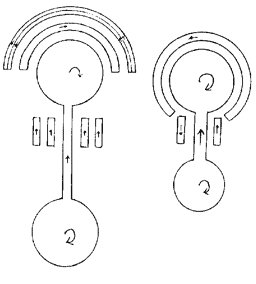 |
Science Frontiers ONLINE No. 75: May-Jun 1991 |
|
|
Crop Circle Roundup
Summary of Britain's 1990 crop circles.
"Over seven hundred circles were found in Britain in 1990, the earliest in April, the latest toward the end of August. They were spread across thirty counties, including Wales and Scotland, besides which there were numerous good reports of circles from Ireland, Holland, Bulgaria, Japan (at least twenty), Canada (over twenty), the U.S.A. and some other countires. The large British total was made possible because of the cooperation of so many enthusiasts via the nationwide CERES organisation."As usual for Britain most circles were found in wheatfields, but there were some reports from fields of barley, rapeseed, linseed, and long grass grown for silage. In 1990, as in 1989, Wiltshire dominated the British scene with about 70% of the year's total. This year the leading counties were Wiltshire: over 400; Hampshire: over 50; Norfolk: 18; Devon: 17; Sussex: 16; Oxfordshire: 13; Buckinghamshire: 12; and so on."
In his review of the 1990 phenomena, G.T. Meaden dwelt on the Hampshire dumbbell formations. From these many spectacular "circles" we focus on the one at Seven Barrows, Hampshire.
 Two of the 1990 Hampshire dumbell formations. (L) Near Seven Barrows; (R) Near Morestead. |
"The next system [see figure] was at Seven Barrows, north of Litchfield, Hampshire near the A34 highway to Newbury. On the evening of 22 June I pointed out this featureless field to conference members as we drove past following our circles tour, saying that this was a 'repeater' region for circles events (circles are known for these fields for 1976, 1978, 1981, 1983 and 1985). The next morning, the day of the conference, attendees travelling north from Hampshire to Oxford spotted the formation which had appeared overnight. The circles were a hundred metres from a group of Bronze Age barrows which had been there for over three thousand years."
CERES is the Circles Effect Research Group, operated by G.T. Meaden, who is also the Editor of the Journal of Meteorology, U.K. Meaden, a scientist, strongly contends that all crop circles, despite their complexities and seeming symbology, are natural phenomena; namely the products of atmospheric vortices. Yet, he feels compelled to state that "the details of these vortices, the vortex-crop interaction and the resulting crop-circles display many amazing features which denote an extraordinary phenomenon at work -- one which will be shown to have very considerable consequences for physics, meteorology, and other research disciplines in the coming years." (Meaden, G.T.; "The Major Developments in Crop-Circles Research in 1990, Part 1," Journal of Meteorology, U.K., 16:51, 1991.)
Crop-circle formation observed in 1934. July 1934. Eversden, England. The observer was a Miss K. Skin of Cambridg.
"I witnessed a corn circle being formed in 1934. I was gazing over a field of corn waiting to be harvested when I heard a crackling like fire and saw a whirlwind in the centre of the field, spinning stalks, seeds and dust up into the air for about 100 or more feet. I found a perfect circle of flattened corn, the stalks interlaced and their ears lying on top of each other (some even plaited) on the periphery. The circle was hot to the touch."
An interview with Skin confirmed that the plaiting of the stems was the same as observed today, 56 years later. In addition, the same whirlwind created a second circle about 4 meters in diameter in the corner of the same field.
(Meaden, G.T.; "Crop-Circle Formation Witnessed in Cambridgeshire, July 1934." Journal of Meteorology, U.K., 15:389, 1990.)